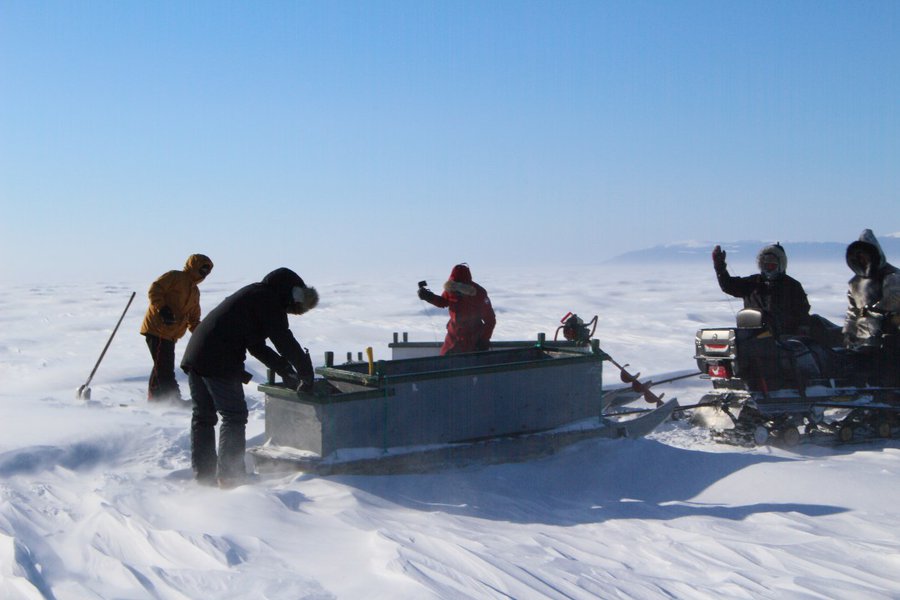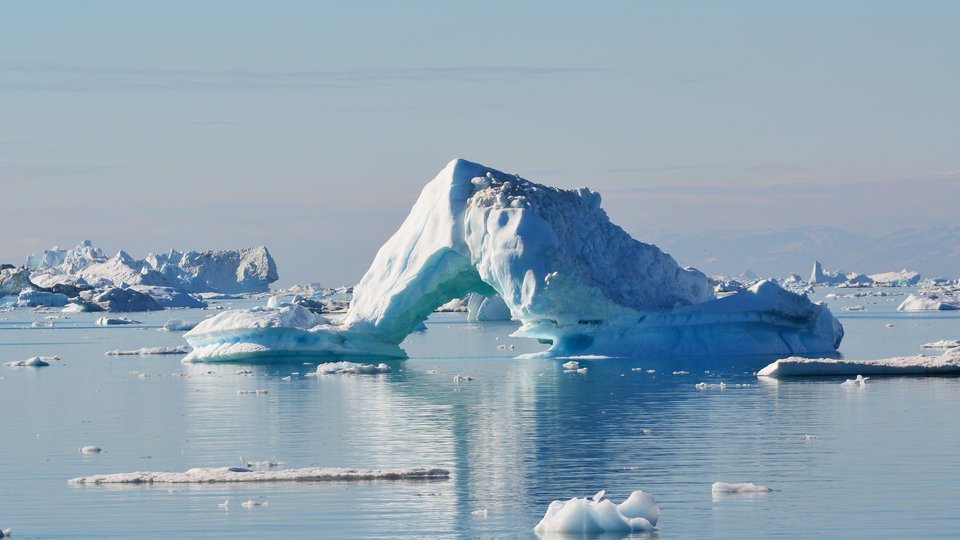
This article was originally published by Northern Public Affairs, an independent, volunteer-run, not-for-profit organization dedicated to mobilizing diverse voices from across the North to analyze and comment on pressing public concerns.
cross the Circumpolar North, shifts in environmental conditions are occurring more frequently and in greater intensity than ever before, largely due to the cumulative and combined effects of climate change and resource development. For Inuit communities, these environmental shifts have both acute and chronic impacts on wellbeing and ways of life. Indeed, Inuit consider the land to be intrinsically connected to wellbeing through a multitude of inextricable pathways; building and strengthening relationships with the land is an underlying foundation for being well.
Rigolet, located in the Labrador Inuit Land Claim Settlement Area, is one of many Inuit communities across the Circumpolar North that has recorded and shared observations related to land, ice, and sea for thousands of years. Inuit in this community have experienced these changes first hand, and knowledge about environmental changes – and associated strategies for mitigating and adapting to these changes – has accumulated over generations.
In recent years, Rigolet has led numerous community-based, participatory research initiatives to adapt to the impacts of changing environmental conditions on health and wellbeing. The community possesses a wealth of experience documenting and analyzing environment- and health-related data. Currently, they are working to mobilize this research to develop response strategies that enhance and support community wellbeing amidst changing environmental conditions. As explained by one community member, the fast pace and immense depth of the impacts of environmental changes on health and wellbeing has underscored the need for immediate, urgent action:
This is our life, this is what we’re livin’ every day, our whole lives … and now that’s why people are all talking about it now because they’re scared they’re gonna lose what they love so much, right? That’s what I think. Why it’s such a hot topic and, why people are so concerned now is because it’s comin’ so fast. And they’re worried about losing their culture and their way of life and their lifestyle.
One such strategy for addressing this need is the integration of both environment and health factors into comprehensive monitoring and response strategies. Indeed, community leaders, public health practitioners, academics, and government stakeholders alike have identified integrated environment and health monitoring as an important strategy for adapting to changing environments while also informing responsive public health policies and programs with and for communities in the North.
Rigolet is at the forefront of these research efforts and is currently developing the eNuk program: a community-driven, participatory, integrated environment and health monitoring initiative. The participatory, community-driven nature of the eNuk program is essential for community members to understand and share relevant, accurate environmental information while also sustaining reciprocal, intimate relationships with the environment.

Charlie Flowers, a research lead and community member in Rigolet, demonstrating the eNuk iPod app.
The Program
The eNuk program was conceptualized and designed by, with, and for Inuit in Rigolet to streamline their existing research efforts into a comprehensive program for monitoring and responding to various community-identified environment and health research priorities. The program builds upon the community’s collective history, knowledge, and experience with monitoring and sharing knowledge about environmental changes.
From its conceptualization through to its implementation, this program is community-led and community-driven. Additionally, it involves an interdisciplinary, multi-sectoral research team consisting of: local and regional government representatives; healthcare professionals; and researchers from the University of Guelph and the Labrador Institute of Memorial University.
This research team is working in partnership with community members to develop an app and associated web-based tools for collecting and tracking environmental observations in the area around Rigolet. Using the eNuk app, community members will record their observations in the form of photos, videos, audio recordings, and text descriptions while travelling, hunting, fishing, and harvesting on the land. Observations collected using the eNuk app can then be uploaded to the website. Once uploaded, participants have the option to either keep their observations private, or share them publicly with the rest of the community.
The Development Process
Between August 2015 and August 2016, community members, local and regional government representatives, healthcare professionals, and the research team worked collaboratively to develop the foundation for this program. Community partners met with the research team to ensure the priorities and goals of all partners were met, and to share feedback and advice on aspects of the research process that needed adjustment.
Community members felt that the most important environmental observations to monitor included: freshwater and sea ice conditions; conditions of trails frequently used for travelling, harvesting, and hunting; trends in animals and wildlife; and weather, temperature, and climate patterns. Additionally, many people felt the eNuk program should be designed to build on what people were already doing to monitor these changes.
Moving beyond the identification of what environmental observations are important to monitor in Rigolet, community members and other project partners explored why monitoring these observations was important, particularly at this point in time when environmental conditions are changing more rapidly and drastically than ever before. This led to discussions about the role of the land in wellness for Inuit in Rigolet. As a result, the eNuk program is grounded in and guided by Inuit values, taking the many dimensions of Inuit wellbeing into account.
Moving beyond the identification of what environmental observations are important to monitor in Rigolet, community members and other project partners explored why monitoring these observations was important, particularly at this point in time when environmental conditions are changing more rapidly and drastically than ever before.
The Priorities
Community members identified three main priorities for the eNuk program: 1) retaining and celebrating environmental stewardship; 2) sharing, protecting, and passing on cultural knowledge; and 3) contributing to evidence-based decision-making.
These priorities were grounded in the central importance of relationships between the land and wellness. For Inuit in Rigolet, environmental changes are important to monitor because they impact wellbeing and ways of living. As a representative from the Nunatsiavut Government explained:
The physical kinds of things around the environment … whether that’s pollutants, whether that’s weather, wind, amounts of snow, rain, it impacts people’s physical health, it impacts people’s mental health, ability to get off to access nutritious foods. Spiritually it impacts people’s connection to the land – being able to maintain that relationship. So it impacts everything really right across the board.
Environmental stewardship: In Rigolet, many people explained that taking care of the land is their responsibility, because it takes care of them. Environmental stewardship is a foundational Inuit societal value, and the perspectives shared by community members in Rigolet show strong agreement with those of other Inuit communities across the country.
Inuit have been monitoring the land for millennia, and keeping track of patterns and trends about various environmental conditions remains a regular part of life for many communities, who often discuss and compare patterns and trends between seasons and over the years. As such, many Inuit possess an immense amount of knowledge and wisdom about the environment and observed changes over time. As explained by another Nunatsiavut Government representative, the eNuk program will help achieve the shared goal of protecting the land:
It’s … making sure that we have, we still have things in the future that we have now and we can still use them the same way. Understanding the fact that things are gonna change, ice is gonna change, weather’s gonna warm up, but make sure that we are [protecting our environment], what we can protect now we should continue to protect.
Sharing, protecting, and passing on cultural knowledge: Through the eNuk program, knowledge sharing can be made more efficient as this program provides a means for Inuit in Rigolet to access information being collected by others in the community in near real-time. For example, the eNuk program can provide a platform for many individual environmental observations, as well as cultural knowledge about the environment, to be shared publicly in one central place, allowing for participants to access a “database” of collective knowledge from their fellow community members when they are making decisions about where and when to travel.
The on-going monitoring of environmental observations, and sharing of cultural knowledge surrounding environmental changes, has important implications for emergency response and personal safety. Indeed, Inuit in Rigolet felt that, in addition to protecting the land, it is important to listen to what the land tells them about how to make informed decisions about land use, and subsequently share this knowledge with their community.
Furthermore, community members in Rigolet felt that intergenerational involvement in the eNuk program should be a major priority in order to prepare younger generations to respond and adapt to current changes in the environment, as well as help to preserve and protect ways of life in unpredictable futures. Engaging youth in monitoring is a way to help transfer Inuit knowledge about the land between generations, as well as foster and protect cultural and traditional values. A community member explained their perspective about the ways in which environmental knowledge and wisdom shared and passed on:
When our children grow up, their whole way of living around this area is gonna be totally different than our grandparents’ … because it’s changing, we have to change how we teach them. So, it goes back to that, the traditional knowledge on how you use the land, what you hunt, what you don’t do, where you don’t go, it’s always changing. And it’s important to take notice of those things.
For Inuit in Rigolet, traditional knowledge is dynamic, evolving knowledge that Inuit across the North possess about the land and marine environments, and is based on long-standing observation, experimentation, and validation.
Supporting evidence-based decision-making: A centralized and community-driven monitoring program such as eNuk can help support more relevant, meaningful evidence-based decision-making. This, in turn, can contribute to the development of more targeted adaptation and mitigation strategies for the community to cope with current changes. Additionally, as a member of the community explained, monitoring changes as they occur will help with assessing potential long-term impacts:
I think that you will see more changes happening every year. And it’s so hard to predict what those changes are, so it’s gonna be important, through programs like what you’re doing, it’s noticing the little changes. ‘Cause it’s those little changes that’s gonna be hints to what the bigger changes gonna be comin’ down the line.
Until written documentation became widespread, oral histories were widely used to pass on knowledge about environmental changes. Now, in Rigolet, observations about environmental changes are often shared through word of mouth and via social media. “Formalizing” informal methods of communication through the eNuk program streamlines information from multiple sources that can be presented to decision-makers. The hope is that the information collected by Inuit in Rigolet through this program can help inform relevant, meaningful policies and programs that prioritize their community’s values and knowledge. A community member shared their perspective on the importance of prioritizing Inuit knowledge and Inuit sciences in environment and health monitoring strategies:
Look, Western science, all that stuff is awesome, it’s good, and gives us the data, but on the other side traditional knowledge is just as important … Yeah and what you’re doing here is you’re, even though you’re using technology and all that stuff, is you’re giving people a means to be able to convey that traditional knowledge.
For Inuit in Rigolet, traditional knowledge is dynamic, evolving knowledge that Inuit across the North possess about the land and marine environments, and is based on long-standing observation, experimentation, and validation. Inuit knowledge or Inuit science is knowledge that is gathered and shared in different ways than in Western science. The eNuk program is building on this Inuit science and knowledge, and on these methods of gathering and sharing information on monitoring the environment that has existed among Inuit for millennia.

The eNuk research team testing out iPods, cameras, and other equipment with community partners on English River in -40 conditions.
The Pathway Forward
A pilot version of the eNuk app and website is currently being tested by a small cohort of community members in Rigolet in 2017. This cohort, along with the rest of the community and all project partners, will provide feedback and suggestions on the development of the overall program to ensure that the final versions of the app and website are engaging, useful, and meet the initial goals set out by the community and project partners.
The eNuk program was developed and implemented with collective direction, leadership, and guidance from community and project partners who generously contributed time and expertise. Moving forward, engagement among all partners via ongoing conversations and consultations will be essential to the success of the eNuk program. The end result will be an integrated community-led monitoring program that is grounded in and guided by Inuit values, knowledge, and science.
The central importance of the land to wellbeing and ways of life in Rigolet necessarily means that in order for the eNuk program to be successful, the pathway forward is and should be led by the community itself, with Inuit autonomy and self-determination at its heart.
Alexandra Sawatzky is a PhD Candidate in Public Health at the University of Guelph. Ashlee Cunsolo is the Director of the Labrador Institute of Memorial University. Dan Gillis is an Associate Professor in the School of Computer Science at the University of Guelph. Oliver Cook is an MSc Candidate in Computer Science at the University of Guelph. Inez Shiwak is the Coordinator of the ‘My Word:’ Storytelling & Digital Media Lab in Rigolet, Nunatsiavut. Charlie Flowers is a Community Research Assistant in Rigolet, Nunatsiavut. Michele Wood is the Researcher/Evaluator at the Nunatisavut Government Department of Health and Social Development. Sherilee Harper is an Assistant Professor in the Department of Population Medicine at the University of Guelph.





